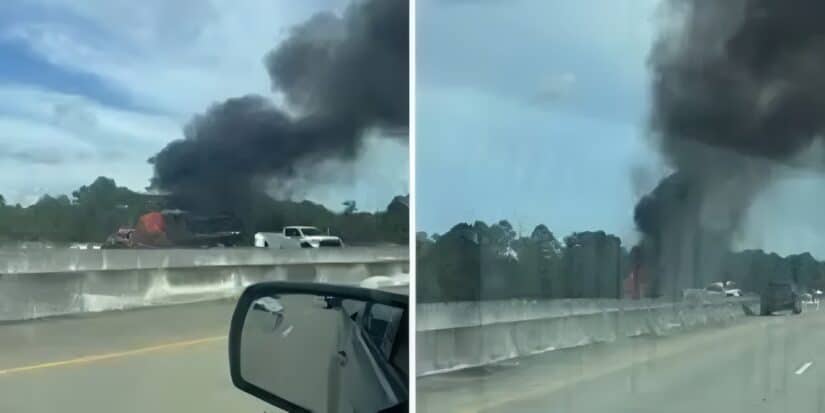
A devastating roadway tragedy unfolded on August 20, 2025, in South Carolina. On the Waccamaw River bridge near Myrtle Beach, a dump truck plowed into traffic, sparking a fiery collision that sent one vehicle plunging into the river. The crash claimed the lives of two innocent people and left the community shaken. Authorities from the Highway Patrol, the Department of Transportation, and the Department of Public Safety quickly launched investigations to determine the cause and prevent similar disasters in the future.
This disaster demonstrates how ignoring speed limits, failing to notice official traffic-control devices, or mishandling heavy Motor Vehicles can instantly turn lives upside down. The incident has sparked renewed debate about safety regulations, the role of each law enforcement officer, and the need for stronger measures under every provision of law.
The Crash in Detail
The accident happened when westbound lanes slowed due to congestion. The dump truck driver did not stop in time, according to the Highway Patrol, and slammed into a Chevrolet SUV. That impact pushed the SUV into a Jeep and a GMC pickup. Flames erupted quickly, fueled by gas and debris.
The Jeep plunged off the bridge, hitting the river below. Witnesses described scenes of panic as drivers scrambled to escape thick smoke and fast-moving fire. This catastrophe revealed vulnerabilities in managing vehicular traffic in a busy urban district like Horry County.
South Carolina officials emphasized the importance of respecting speed limits, obeying official traffic-control devices, and maintaining awareness of changing conditions when heavy Motor Vehicles are on bridges.
Victims and Injuries
The Horry County Coroner identified the victims as Flora Beltran-Gomez, 35, and Earl Burnette, 49, both from South Carolina. Their loss devastated their families and communities.
The driver of the GMC pickup survived but suffered bodily injury requiring hospitalization. The dump truck driver escaped physical harm but faces investigation by the Highway Patrol and law enforcement officers across respective jurisdictions.
Immediate Response
The emergency was met with rapid deployment of firefighters, EMS, and police. Every law enforcement officer at the scene worked under established provision of law to control chaos.
The Department of Transportation inspected the bridge for damage, while the Department of Public Safety coordinated traffic rerouting. This case showed why public service employment in emergency services is crucial. Without responders trained under a plan of education, outcomes could have been worse.
Bridge safety inspections included reviewing official traffic-control devices, analyzing flow of vehicular traffic, and studying adherence to speed limits.
Investigative Focus
The Highway Patrol continues to investigate the driver’s history, including possible involvement in the Alcohol and Drug Safety Action Program. Questions about Motor Vehicles licensing, fatigue, or distraction remain open.
Every crash in South Carolina must be reviewed across respective jurisdictions, ensuring consistency with each provision of law. This includes mechanical inspections, driver records, and roadway safety audits.
The role of law enforcement officers here is central. Their reports guide decisions by courts, agencies, and the Department of Transportation.
Infrastructure and Policy Considerations
The tragedy reignited debate on bridge safety in South Carolina. Many urban districts rely on bridges for daily commutes. If official traffic-control devices are unclear or speed limits unenforced, risks increase.
The Department of Transportation has announced studies into better signage, crash barriers, and digital alerts through Traffic Driver apps. These platforms allow commuters to Sign up for a personalized timeline of incidents, though some users complain of excessive targeted advertising and confusing Terms of Service.
Still, better communication could save lives. A sixteen one-hundredths second delay in reaction time may cause devastation if Motor Vehicles are speeding.
Broader Social Reflections
Tragedies like this ripple through South Carolina communities. Families in nursing homes worry about safe transport for elderly residents. Advocates debate whether Medicaid cuts will undermine hospital readiness to handle mass casualty events.
Even unrelated issues like the SEC’s 9-game schedule or sports headlines about Shane Beamer pale in comparison to human loss. Road safety touches everyone, regardless of occupation or background.
Public trust relies on strong systems: the Department of Public Safety, the Department of Transportation, and law enforcement officers enforcing speed limits and monitoring Motor Vehicles. Each operates under its provision of law and within respective jurisdictions to safeguard people.
Education and Prevention
Experts argue for stronger driver training programs, part of a long-term plan of education. Teaching about official traffic-control devices, the dangers of ignoring speed limits, and the risks of impaired driving is vital.
The Alcohol and Drug Safety Action Program continues to educate drivers across South Carolina, but expansion may be necessary. Combined with better public service employment funding, investment in prevention could reduce tragedies.
Technology may help. New Traffic Driver tools, when not overloaded by targeted advertising, can give drivers real-time updates. By encouraging more people to Sign up, officials hope to expand reach.
Community Calls for Action
Residents across South Carolina are calling for accountability. Families want assurance that every law enforcement officer involved is investigating thoroughly. They demand reforms from the Department of Transportation, from improved official traffic-control devices to stricter speed limits enforcement.
They also question whether the Department of Public Safety has adequate resources for urban district traffic monitoring. Citizens argue that too often, road tragedies are overlooked until another crash occurs.
Debates extend into policy: How will future budgets balance road safety against other programs, especially in light of potential Medicaid cuts? How do we weigh safety needs versus unrelated political issues like the SEC’s 9-game schedule?
Final Reflections
The fiery crash on Highway 22 in South Carolina is a solemn reminder of life’s fragility. Two innocent lives were lost, and countless others were shaken.
Respecting speed limits, obeying official traffic-control devices, and valuing every law enforcement officer’s role can prevent devastation. Agencies like the Department of Transportation and the Department of Public Safety must continue their mission across respective jurisdictions under each provision of law.
The community’s grief fuels determination. The message is clear: no delay, no sixteen one-hundredths of a second, should be wasted when lives are at stake.
